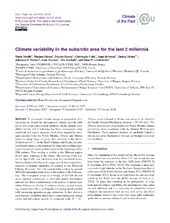| dc.contributor.author | Nicolle, Marie | |
| dc.contributor.author | Debret, Maxime | |
| dc.contributor.author | Massei, Nicolas | |
| dc.contributor.author | Colin, Christophe | |
| dc.contributor.author | de Vernal, Anne | |
| dc.contributor.author | Divine, Dmitry V | |
| dc.contributor.author | Werner, Johannes | |
| dc.contributor.author | Hormes, Anne | |
| dc.contributor.author | Korhola, Atte | |
| dc.contributor.author | Linderholm, Hans W. | |
| dc.date.accessioned | 2019-06-03T14:22:46Z | |
| dc.date.available | 2019-06-03T14:22:46Z | |
| dc.date.issued | 2018-01-25 | |
| dc.Published | Nicolle M, Debret M, Massei N, Colin C, de Vernal A, Divine D, Werner J, Hormes A, Korhola A, Linderholm HW. Climate variability in the subarctic area for the last 2 millennia. Climate of the Past. 2018;14(1):101-116 | eng |
| dc.identifier.issn | 1814-9332 | en_US |
| dc.identifier.issn | 1814-9324 | en_US |
| dc.identifier.uri | https://hdl.handle.net/1956/19843 | |
| dc.description.abstract | To put recent climate change in perspective, it is necessary to extend the instrumental climate records with proxy data from paleoclimate archives. Arctic climate variability for the last 2 millennia has been investigated using statistical and signal analyses from three regionally averaged records from the North Atlantic, Siberia and Alaska based on many types of proxy data archived in the Arctic 2k database v1.1.1. In the North Atlantic and Alaska, the major climatic trend is characterized by long-term cooling interrupted by recent warming that started at the beginning of the 19th century. This cooling is visible in the Siberian region at two sites, warming at the others. The cooling of the Little Ice Age (LIA) was identified from the individual series, but it is characterized by wide-range spatial and temporal expression of climate variability, in contrary to the Medieval Climate Anomaly. The LIA started at the earliest by around AD 1200 and ended at the latest in the middle of the 20th century. The widespread temporal coverage of the LIA did not show regional consistency or particular spatial distribution and did not show a relationship with archive or proxy type either. A focus on the last 2 centuries shows a recent warming characterized by a well-marked warming trend parallel with increasing greenhouse gas emissions. It also shows a multidecadal variability likely due to natural processes acting on the internal climate system on a regional scale. A ∼ 16–30-year cycle is found in Alaska and seems to be linked to the Pacific Decadal Oscillation, whereas ∼ 20–30- and ∼ 50–90-year periodicities characterize the North Atlantic climate variability, likely in relation with the Atlantic Multidecadal Oscillation. These regional features are probably linked to the sea ice cover fluctuations through ice–temperature positive feedback. | en_US |
| dc.language.iso | eng | eng |
| dc.publisher | Copernicus Publications under license by EGU | en_US |
| dc.rights | Attribution CC BY | eng |
| dc.rights.uri | http://creativecommons.org/licenses/by/3.0/ | eng |
| dc.title | Climate variability in the subarctic area for the last 2 millennia | en_US |
| dc.type | Peer reviewed | |
| dc.type | Journal article | |
| dc.date.updated | 2019-03-03T17:52:51Z | |
| dc.description.version | publishedVersion | en_US |
| dc.rights.holder | Copyright 2018 The Authors | en_US |
| dc.identifier.doi | https://doi.org/10.5194/cp-14-101-2018 | |
| dc.identifier.cristin | 1591217 | |
| dc.source.journal | Climate of the Past | |

